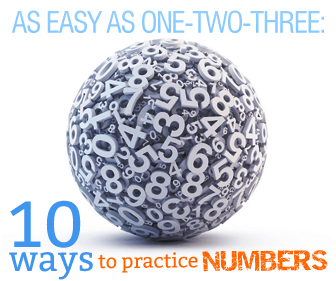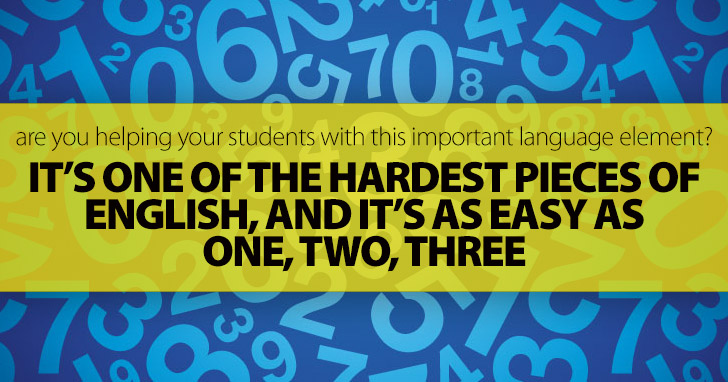As Easy as OneTwoThree: 10 Ways to Practice Numbers in the ESL Classroom

It has been said that math is a universal language. Whether you’re in China, Brazil, or the United States, 2+2 always equals 4. However, those universal facts are not expressed the same way in each language. In English, you may say two plus two equals four, but that becomes dois mais dois são iguais a quarto in Portuguese, and 兩加二等於四 in traditional Chinese. For English language learners to be successful, they need to learn how to express the language of math in English.
English language learners need to be introduced to key math vocabulary words. These include words such as add, subtract, multiply, and divide, as well as words such as equals, sum, difference, product, and factor.
Some resources to help students learn math vocabulary words include:
Estimating Time: Hours or minutes? – Students read each scenario and determine whether it took hours or minutes, helping them understand the difference between the two words.
Classifying Quadrilaterals – This worksheet helps students learn shape names and properties through a series of multiple choice questions.
Abbreviations - Measurement – With this short video lesson students can learn words and abbreviations for common measurements.
Math in English - Teachers read out a set of instructions, such as "Add two plus four" and students complete the problem. This helps students recognize the words without the aid of numbers on the page. A crossword puzzle is also include to reinforce the vocabulary used in the activity.
While number words share similar sounds in many languages, English language learners may be stumped by their English counterparts. Early language learners should learn to count from one to ten in English, then to twenty, and finally up to one-hundred. Even simple dot-to-dot worksheets are great to use for simple counting practice. Once they have the basic numbers down, they can be introduced to thousand, million, billion, and beyond.
Some resources to encourage counting include:
Counting to 10 – Encourage students to count along with the video to learn the numbers from one to ten.
Multiplication Chart 1 to 10 – Have students fill in the chart and say each number aloud as they write it.
Numbers: Fill in the Blank – Students can practice counting numbers in sequence and write in the missing numbers when they come to them.
When working with English language learners, it helps to include visual elements in math instruction. This includes images of counting cubes, pictographs, and illustrations that help students decode word problems. Even simply writing out numbers in multiple forms can help English language learners begin to connect the English language to the mathematical concepts they already know.
Some resources to use when incorpoaring images and models include:
Nets – Basic Solids – Print out the worksheet and have students cut out and form the shapes. As they form the shapes, have students say the name of the shape they are making. The kinesthetic component will help students commit the name to memory.
Weather Pictograph – Students can look at the pictures in the graph to help them answer the questions, and then practice saying the numbers aloud.
Number Coloring Mini Book – Mini books, such as this book that contains numbers, combine words with pictures to help students make visual connections.
Talking about math can help students improve their English skills while talking about a subject that may be more familiar. As students talk about how they solved a problem, they are given the opportunity to use key math vocabulary words and common patterns of speech. Teachers can encourage English language learners by offering their own explanations of the processes students followed to help model the language they need to develop.
Some resources to use while talking about math:
Multi-Step Algebraic Equations – The equations on this worksheet are numbers based and include more than one step, so students can solve the equations, and then talk about the steps they took to solve them.
Solving for Variables – Video lessons, such as this one about solving for variables, give students the opportunity to listen to someone else talk about math while seeing the steps on the screen at the same time.
Simple Word Problems - This worksheet contains word problems that contain simple language. The numbers are also written out to help students understand English number words. As students solve the problems, they can explain their thinking.
Every student is different, but teachers should not make the mistake of assuming English language learners have limited math proficiency. Teachers may want to consider giving students a math test in their own language or using a short timed math test to gauge a student's ability level, and then group students based on mathematical skill rather than English language proficiency. By talking about a common subject, students who are less proficient in English may learn from students who are more proficient in English and at the same level in math.
To discover ways to assess math proficiency or bring more creative math ideas into the ESL classroom, check out As Easy as OneTwoThree: 10 Ways to Practice Numbers in the ESL Classroom.


